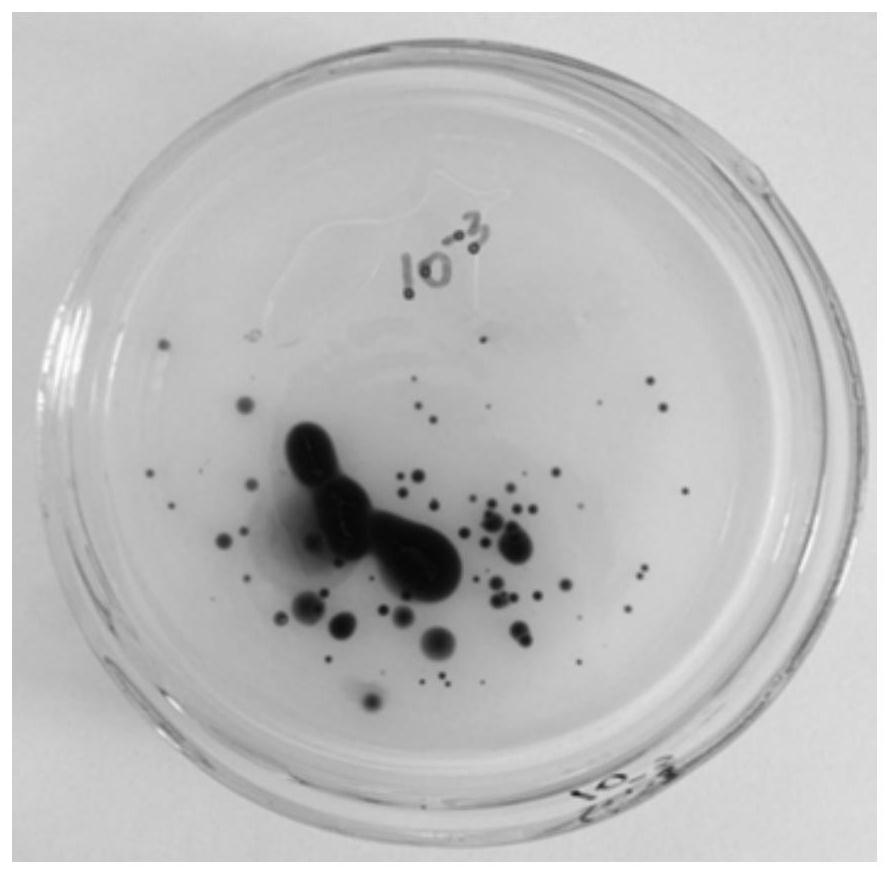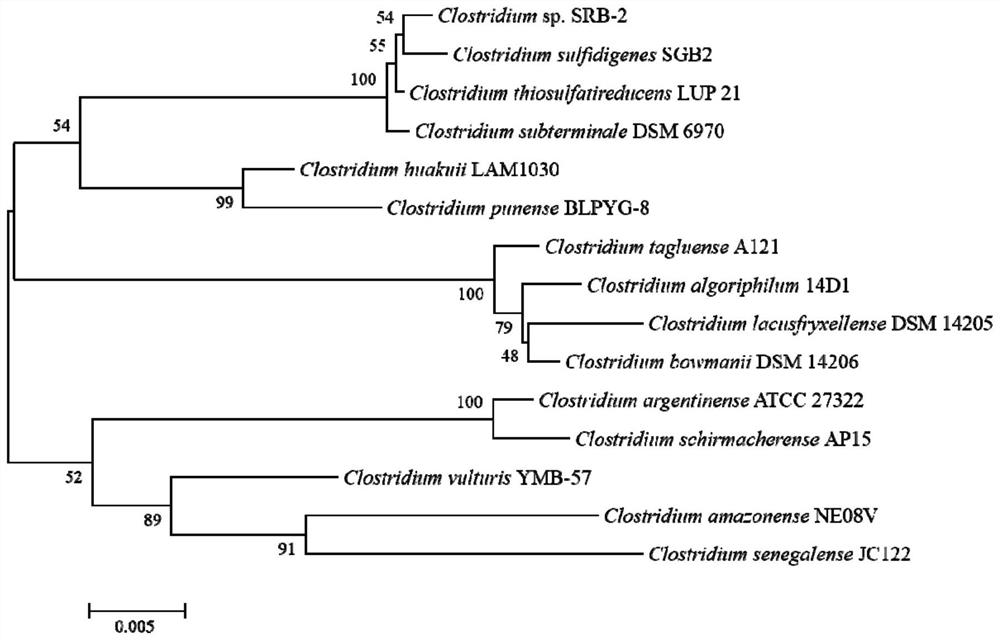Culture method of sulfate-reducing bacterial strain, sulfate-reducing bacterial strain and application
A culture method and sulfate technology, applied in the field of microorganisms, can solve the problems of limited expansion application, low governance efficiency, and poor general governance effect.
- Summary
- Abstract
- Description
- Claims
- Application Information
AI Technical Summary
Problems solved by technology
Method used
Image
Examples
Embodiment 1
[0045] The method for separating and purifying sulfate-reducing bacterial strains specifically comprises the following steps:
[0046] The strain SRB-2 obtained in this example was enriched and cultured from DPAA-contaminated flooded soil, and isolated and screened.
[0047] Enrichment culture method: Take 5mL of the mixed soil suspension and transfer it to a serum bottle containing 95mL of modified Postgate B medium, exchange the upper layer of air with nitrogen, and seal it with an aluminum cover with a Teflon inner pad Put it in a constant temperature incubator and let it stand for 1 to 2 weeks, until the medium turns black. The production of H2S was detected by wetted lead acetate test paper to prove that the cultivation was good. Use the enrichment medium to enrich the bacterial solution for 2 to 3 times.
[0048] The medium for enrichment culture is modified Postgate B medium, its components are: its components are: K 2 HPO 4 ·3H 2 O0.5g, NH 4 Cl 1.0g, Na 2 SO 4 ...
Embodiment 2
[0062] The cultivation method and specific effect evaluation of the sulfate-reducing bacterial strain are carried out according to the following steps:
[0063] 1) Prepare Postgate B medium: K 2 HPO 4· 3H 2 O 0.3g / L, NH 4 Cl 1.5g / L, Na 2 SO 4 2g / L, CaCl 2 2H 2 O 0.06g / L, MgCl 2 ·6H 2 O 0.2g / L, sodium lactate 4g / L, yeast extract 0.5g / L, solvent is water, adjust pH 7.0.
[0064] 2) Add diphenylarsenic acid (DPAA) to the above-mentioned Postgate B medium, the concentration after addition is 2mg / L, and add goethite at the same time (addition of iron mineral is to simulate the DPAA in the soil under real conditions is easy to adsorb on iron minerals in the soil), and inoculate the Clostridium sp.SRB-2 bacterial solution cultivated to the logarithmic phase according to the inoculum amount of 5%, and set the control CK without inoculation (the blank medium without SRB-2 bacteria ), replace the upper layer of air with high-purity nitrogen, seal it with a polytetrafluoroethy...
Embodiment 3
[0069] The culture method of sulfate-reducing bacterial strain is carried out according to the following steps:
[0070] 1) Prepare Postgate B medium: K 2 HPO 4 ·3H 2 O 1g / L, NH 4 Cl 0.5g / L, Na 2 SO 4 4g / L, CaCl 2 2H 2 O 0.02g / L, MgCl 2 ·6H 2 O 0.6g / L, sodium lactate 2g / L, yeast extract 1.5g / L, solvent is water, adjust pH 7.0.
[0071] 2) Add diphenylarsenic acid (DPAA) to the above-mentioned Postgate B medium, the concentration after addition is 10mg / L, and add goethite at the same time (adding iron minerals is to simulate the DPAA in the soil under real conditions is easy to adsorb on on the iron minerals in the soil), and inoculate the Clostridiumsp. -2 bacterial blank culture medium), replace the upper layer of air with high-purity nitrogen, seal it with a polytetrafluoroethylene inner pad and an aluminum cover, place it in a shaking incubator, and culture it in the dark at 35°C and 180r / min.
[0072] Subsequent analysis of SO in the culture system 4 2- After...
PUM
| Property | Measurement | Unit |
|---|---|---|
| thickness | aaaaa | aaaaa |
Abstract
Description
Claims
Application Information
 Login to View More
Login to View More - R&D
- Intellectual Property
- Life Sciences
- Materials
- Tech Scout
- Unparalleled Data Quality
- Higher Quality Content
- 60% Fewer Hallucinations
Browse by: Latest US Patents, China's latest patents, Technical Efficacy Thesaurus, Application Domain, Technology Topic, Popular Technical Reports.
© 2025 PatSnap. All rights reserved.Legal|Privacy policy|Modern Slavery Act Transparency Statement|Sitemap|About US| Contact US: help@patsnap.com



